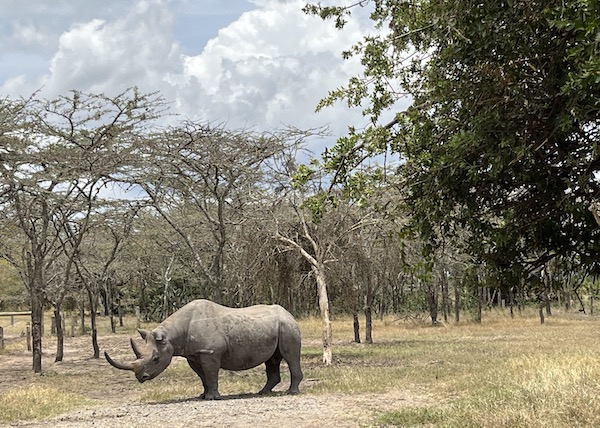A major problem in Kenya is wildlife conservation. There are only 2 female northern white rhinos left in the world! This is mainly because of habitat loss and poaching, mainly to meet the high demand of the rhino horn. Some of you may know that rhino horn is not ivory but is made of the same thing as our fingernails! The poachers aren’t the only bad guys, but a whole chain of people buying and selling the horns.
The reason
The main reason for rhino poaching is because there are people who think that the horn is a miracle medicine that can cure many illnesses like cancer, heart disease and even aging. While this might be due to their culture or belief, there are no medical studies that prove rhino horn can cure these ailments. A single gram of rhino horn dust can fetch $1000 on the black market. Most illegally smuggled rhino horns pass by Vietnam. Some shops sell special horn grinding bowls with images of rhinos etched on the side. The reasons are numerous and complicated like an intricate web of blame. For example, poachers blame the demand and the government blames the poachers. The Vietnamese sellers blame the Chinese and say that most of the rhino horn goes to China. Everyone blames each other.
Worth more alive than dead
Even though you can make tons of money by selling horns, rhinos are worth more alive than dead.
I learnt this phrase from the Nairobi National Park at the ivory burning site and the phrase also applies to rhinos. One can interpret this phrase in more than one way. Rhinos are a part of Kenyas cultural heritage so keeping them alive would be like keeping a part of the country alive. The economic value would be that a living rhino can generate millions of dollars while a rhino horn can only sell for tens of thousand dollars.
Ol Pejeta
Not long ago, I was lucky enough to visit the Ol Pejeta conservancy where the two rhinos are kept. The rhinos are not native to the area and were put in Ol Pejeta as a conservation effort. We saw and got really close to a blind black rhino called Baraka and learned many facts about the southern, northern and black rhinos. White rhinos have square shaped lips for grazing and the black ones have triangular lips for browsing. Black and white rhinos are all endangered. It is the northern white rhino that is in the most dire situation because there are only two left in the world.
Let’s stop this
There are many ways to stop this but the best way is to stop the demand for rhino horns. There is no miracle medicine, so there is no good reason to kill rhinos. Stopping the demand is one thing. Thinking creatively is another.
There are currently people who are using technology to bring back this species. Because both the white rhinos can’t have healthy babies, the scientists extracted the eggs from the white rhinos and mixed it with some frozen sperm collected from when the males were still living, then they planted that into a southern rhino to act as a surrogate mom. There are only two female northern white rhinos so we definitely don’t want them extinct, especially when the scientists are trying to create more. If they become extinct, we will have lost another species to extinction.
Another species in trouble
The northern white rhinos are not the only species that are in danger of being wiped off the face of the Earth. While the northern white rhinos are on the brink of extinction, many other species like sea turtles are critically endangered. There are an estimated 100,000 green sea turtles left in world and that might seem like a lot but it is not compared to how many there used to be in our oceans.
Local Ocean Conservation
Today I visited a local sea turtle education non-profit center called “Local Ocean Conservation” near our Airbnb and they showed me lots of interesting information that I never even knew about. Over the last 200 years, human activities have really affected the survival of these majestic creatures. Poached for their eggs, meat and shells, sea turtles suffer from poaching and plastic pollution. They also face habitat destruction and accidental capture (known as bycatch) from fishing
Poaching
Sea turtles continue to be poached unsustainably and illegally both for human consumption and trade of their parts. Turtle meat and eggs are a delicacy and people pay a lot to eat it around the world. Some also kill turtles for their oil which is used as a traditional medicine. Sea turtle shells are also used to make hair accessories, combs and glasses. Many sea turtles die this way every year, killing hundreds of already endangered greens and hawksbills are decreasing by the minute.
Pollution
Pollution is also a big problem for the sea turtles. Sea turtles often mistaken plastic materials for jellyfish and can choke on them when they try to eat them and also they can eat it and start to float upwards and die of starvation. These encounters are mostly deadly. Discarded fishing gear traps sea turtles and can drown or render a turtle unable to feed or swim. Trash on beaches can trap hatchlings and prevent them from reaching the ocean. Oil spills also poison sea turtles of all ages. Inside the Local Ocean Conservation Center, there is a turtle hospital where turtles with fibros caused by water pollution can be treated. Pollution in the water causes tumors to grow on the turtles’ bodies and eyes, which can cause them to go blind.
Habitat loss
Habitat loss is a major problem for them also. Sea turtles need beaches for nesting. Traffic on beaches, and other human activities have either directly destroyed or disturbed sea turtle nesting beaches around the world. Lights from roads and buildings draw hatchlings away from the sea, as they follow the moon to get in the sea, and traffic on beaches makes the sand compact, and it is extremely hard for female turtles to dig their nests. Turtle feeding grounds such as coral reefs and seagrass beds are damaged by onshore activities also.
Our Responsibility
As a child and as a member of the human race, I have a responsibility to learn about the challenges the world is facing, not just in my own life or my community. I may not be able to do anything significant about it now but it is my responsibility to do what I can, to learn about it and to be aware. Personally, what I can do now is to be a responsible tourist and not buy that much single use plastic. More importantly, having awareness of these issues will help me to make informed choices as I get older.
Sources:
Ebersol, R. There are two northern white rhinos left on Earth. Can a controversial approach save them. National Geographic. Animals. September 19, 2023. https://www.nationalgeographic.com/premium/article/northern-white-rhinoceroses-endangered-deextinction
Personal visits to Ol Pejeta Conservancy in Nanyuki and Local Ocean Conservation in Watamu
Rhinos Under Threat. CITES (the Conservation on International Trade in Endangered Species). June 18 2012. Rio de Janeiro. https://cites.org/eng/prog/terrestrial_fauna/Rhinoceroces
WWF Website. Species. Sea Turtles. https://www.worldwildlife.org/species/sea-turtle.
Author
-

Rand is a 12 year old boy who has lived in China his whole life. He enjoys cooking, playing video games, crafting one-of-a-kind hand-made creations and hanging out with his friends.


Great research and very educational article. I enjoyed reading about the problems and the solutions.
This is such a well-written article Rand! The other responsibility you’re taking on is spreading the word, and this piece is an excellent way to do that. Keep them coming!